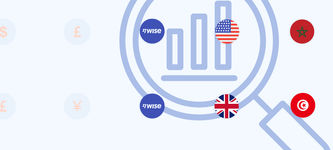Europe: Remittance Data and Statistics
This data page covers the average costs since 2016 for sending money to Europe. This includes the average fee and exchange rate paid.
Banks and money transfer companies are the most popular ways to send remittance to Europe and make up most of this data.

Remittance statistics for Europe
The cost of sending money to Europe has been above 5% consistently since 2019, except for Q1 2019, where the average cost was 4.97%.
Q3 2023 saw the highest average cost, at 8.42%. This is only the second time the average cost exceeded 8%. The first instance was in Q2 2022, at 8.15%.
Banks, on average, have hugely increased the cost for transfers into Europe. Since Q2 2022, transferring to Europe using a bank account has been at least 12%, but has been as high as 17%.
Despite banks being able to offer a more competitive exchange rate between countries supporting the EUR, the amount charged in fees for international transfers still makes them the most expensive option.
Average cost of sending money to Europe
This graph shows the average cost of sending money into Europe from 2016 to date and is based on a $200 transfer. This includes countries that support EUR to EUR transfers as well. We have included these to highlight the impact of unreasonably high fees on the overall cost of sending money.
The data below outlines the average cost of sending money to Europe in the last quarter of every year. Full data is in each of the other tabs.
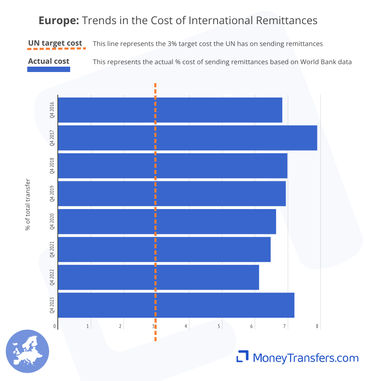
The data below shows the average cost as a percentage of the overall transfer for every quarter since 2016. This includes transfers between EUR to EUR as well.
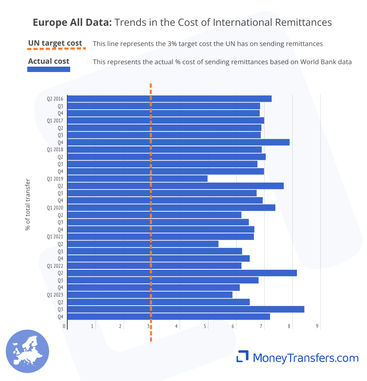
Here are the numbers behind the graphs.
Date: Quarter, Year | % of transfer |
|---|---|
Q2, 2016 | 7.25% |
Q3, 2016 | 6.84% |
Q4, 2016 | 6.83% |
Q1, 2017 | 6.99% |
Q2, 2017 | 6.89% |
Q3, 2017 | 6.87% |
Q4, 2017 | 7.89% |
Q1, 2018 | 6.90% |
Q2, 2018 | 7.04% |
Q3, 2018 | 6.75% |
Q4, 2018 | 6.98% |
Q1, 2019 | 4.97% |
Q2, 2019 | 7.68% |
Q3, 2019 | 6.72% |
Q4, 2019 | 6.94% |
Q1, 2020 | 7.39% |
Q2, 2020 | 6.18% |
Q3, 2020 | 6.44% |
Q4, 2020 | 6.64% |
Q1, 2021 | 6.62% |
Q2, 2021 | 5.36% |
Q3, 2021 | 6.20% |
Q4, 2021 | 6.47% |
Q1, 2022 | 6.18% |
Q2, 2022 | 8.15% |
Q3, 2022 | 6.79% |
Q4, 2022 | 6.12% |
Q1, 2023 | 5.86% |
Q2, 2023 | 6.47% |
Q3, 2023 | 8.42% |
Q4, 2023 | 7.20% |
Europe: Cost by type of company
Banks and money transfer operators are generally the most popular ways of sending money to Europe. The data below focuses on these types of company.
Q4 2023 is not yet available for banks, but we can see a general trend in cost increases for transfers into,and within Europe.
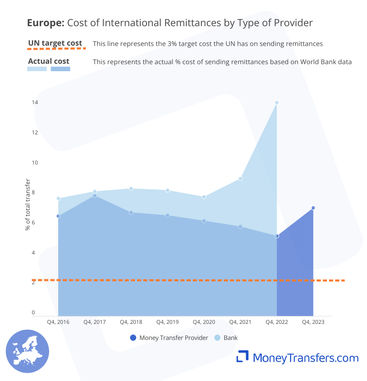
This data highlights quarterly data for sending money into Europe and the amount that can be expected to be paid. Banks have increased costs for sending money to Europe over the last 2 years.
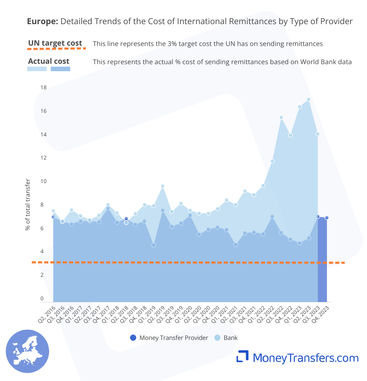
The following table shows the data behind each of these two graphs.
Date: Quarter, Year | Money Transfer Operator | Bank |
|---|---|---|
Q2, 2016 | 7.26% | 7.80% |
Q3, 2016 | 6.88% | 6.86% |
Q4, 2016 | 6.66% | 7.84% |
Q1, 2017 | 6.90% | 7.35% |
Q2, 2017 | 6.92% | 7.03% |
Q3, 2017 | 6.82% | 7.39% |
Q4, 2017 | 8.03% | 8.32% |
Q1, 2018 | 6.78% | 7.61% |
Q2, 2018 | 7.13% | 6.77% |
Q3, 2018 | 6.62% | 7.55% |
Q4, 2018 | 6.91% | 8.32% |
Q1, 2019 | 4.85% | 8.19% |
Q2, 2019 | 7.83% | 9.88% |
Q3, 2019 | 6.44% | 7.72% |
Q4, 2019 | 6.72% | 8.40% |
Q1, 2020 | 7.38% | 7.82% |
Q2, 2020 | 5.78% | 7.56% |
Q3, 2020 | 6.19% | 7.58% |
Q4, 2020 | 6.37% | 7.95% |
Q1, 2021 | 6.16% | 8.70% |
Q2, 2021 | 4.89% | 8.30% |
Q3, 2021 | 5.87% | 9.47% |
Q4, 2021 | 5.97% | 9.16% |
Q1, 2022 | 5.82% | 9.92% |
Q2, 2022 | 7.31% | 12.01% |
Q3, 2022 | 5.92% | 15.76% |
Q4, 2022 | 5.34% | 14.22% |
Q1, 2023 | 5.05% | 16.66% |
Q2, 2023 | 5.45% | 17.29% |
Q3, 2023 | 7.31% | 14.35% |
Q4, 2023 | 7.20% | No Data |
Why are money transfer companies cheaper for transfers to Europe?
Generally, a money transfer company is cheaper for sending money to Europe than a bank because they use their own network.


Average FX markups for transfers to Europe
The markup, as part of a transfer, can equate to hidden costs or a hidden fee for sending money. Essentially, the higher the markup, the less a recipient in Europe will eventually end up with.
Average FX markup to Europe is one of the cheapest among continents. This is due to the use of the Euro across multiple countries.
Banks can offer a mid-market rate on transfers, but often fall down on fees added.
Money transfer companies offer an average markup of around 2%.
The average bank exchange rate has stayed under 1% since data has been recorded.
The graph below shows the average FX markup for transfers into Europe. The increase in Q4 2023 is a result of no data for banks being available at the time of writing. With many banks offering no markup, removing this has increased the average.
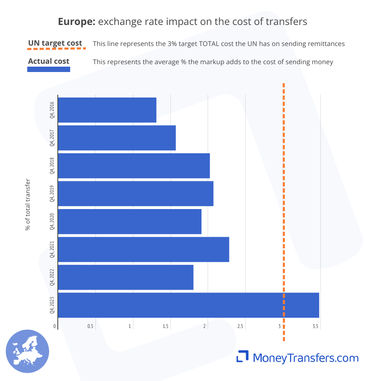
The following highlights the average cost of sending money to Europe by quarter since 2016.
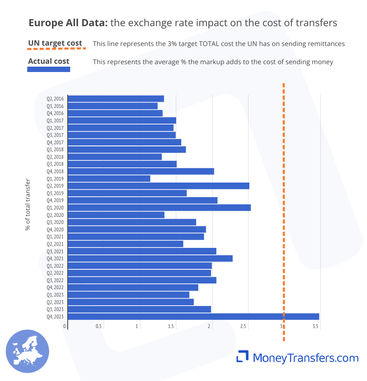
This table shows the data behind each of the graphs.
Date: Quarter, Year | Average FX margin on a $200 transfer |
|---|---|
Q2, 2016 | 1.33% |
Q3, 2016 | 1.24% |
Q4, 2016 | 1.31% |
Q1, 2017 | 1.50% |
Q2, 2017 | 1.46% |
Q3, 2017 | 1.49% |
Q4, 2017 | 1.57% |
Q1, 2018 | 1.63% |
Q2, 2018 | 1.30% |
Q3, 2018 | 1.50% |
Q4, 2018 | 2.02% |
Q1, 2019 | 1.14% |
Q2, 2019 | 2.51% |
Q3, 2019 | 1.64% |
Q4, 2019 | 2.07% |
Q1, 2020 | 2.53% |
Q2, 2020 | 1.33% |
Q3, 2020 | 1.77% |
Q4, 2020 | 1.91% |
Q1, 2021 | 1.88% |
Q2, 2021 | 1.60% |
Q3, 2021 | 2.05% |
Q4, 2021 | 2.28% |
Q1, 2022 | 1.99% |
Q2, 2022 | 1.98% |
Q3, 2022 | 2.05% |
Q4, 2022 | 1.80% |
Q1, 2023 | 1.68% |
Q2, 2023 | 1.74% |
Q3, 2023 | 1.98% |
Q4, 2023 | 3.48% |
FX Markup by type of company
The below graphs show the same trends and changes by company type. This again focuses on banks and money transfer companies as the most popular provider types for sending money internationally.
FX markup from banks has been under 1% on average since 2016. Money transfer companies remain competitive by offering lower fees.
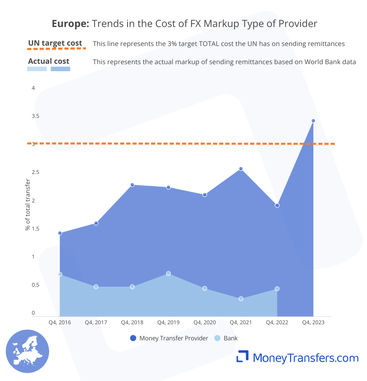
This data highlights the changing trends of the average exchange rate when sending money into Europe.
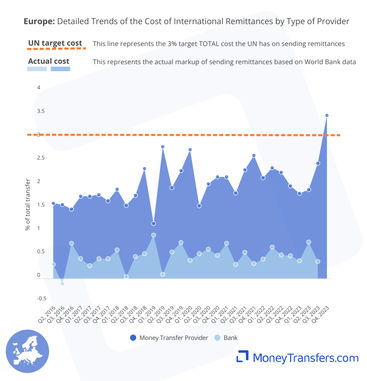
Here is the data for remittances to Europe visualized in each graph.
Date: Quarter, Year | Money transfer provider | Bank |
|---|---|---|
Q2, 2016 | 1.60% | 0.30% |
Q3, 2016 | 1.58% | -0.11% |
Q4, 2016 | 1.48% | 0.75% |
Q1, 2017 | 1.75% | 0.43% |
Q2, 2017 | 1.76% | 0.28% |
Q3, 2017 | 1.79% | 0.42% |
Q4, 2017 | 1.66% | No data |
Q1, 2018 | 1.90% | 0.61% |
Q2, 2018 | 1.56% | 0.04% |
Q3, 2018 | 1.77% | 0.47% |
Q4, 2018 | 2.34% | 0.53% |
Q1, 2019 | 1.17% | 0.93% |
Q2, 2019 | 2.81% | 0.09% |
Q3, 2019 | 1.94% | 0.57% |
Q4, 2019 | 2.30% | 0.76% |
Q1, 2020 | 2.75% | 0.39% |
Q2, 2020 | 1.55% | 0.53% |
Q3, 2020 | 2.01% | 0.63% |
Q4, 2020 | 2.16% | 0.50% |
Q1, 2021 | 2.17% | 0.75% |
Q2, 2021 | 1.82% | 0.31% |
Q3, 2021 | 2.31% | 0.56% |
Q4, 2021 | 2.63% | 0.32% |
Q1, 2022 | 2.15% | 0.42% |
Q2, 2022 | 2.36% | 0.67% |
Q3, 2022 | 2.27% | 0.50% |
Q4, 2022 | 1.97% | 0.49% |
Q1, 2023 | 1.81% | 0.38% |
Q2, 2023 | 1.90% | 0.78% |
Q3, 2023 | 2.46% | 0.36% |
Q4, 2023 | 3.48% | No Data |
Fees and other costs for remittance into Europe
This data shows the other costs and fees associated with sending money into Europe as a percentage of the overall transfer. The data is from 2016 to date. Generally, these will be fees charged, potentially including intermediary fees and receiving fees.
Fees for sending money to Europe have shown consistent decreases since 2016, with Q4 2023 at 3.42% compared to the starting number of 5.93%.
Fees for using a bank hit just under 14% of the amount of a transfer into Europe at the end of 2022. In Q1 and Q2 of 2023, this increased to over 16%.
For comparison, fees for money transfer companies were between 3% and 3.70% for the same period, hitting a brief high of 4.85% in Q3 2023 before returning to normal.
The below graph shows the average cost of sending money to Europe, alongside the overall UN target of 3%.
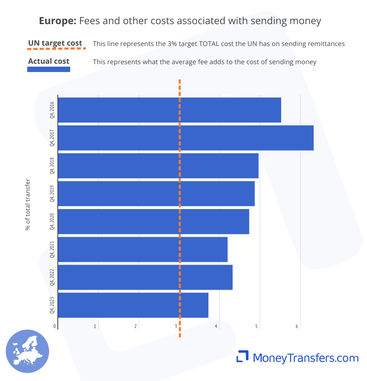
This table shows the data in greater detail for each of the tracked quarters.
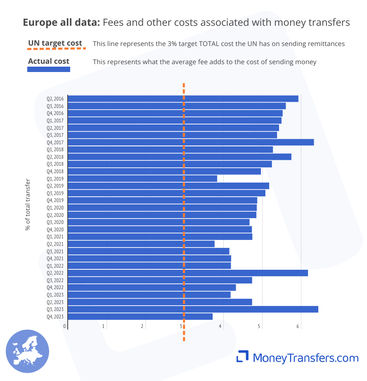
Here are the full numbers behind each of the graphs.
Date: Quarter, Year | Total Cost Minus Markup (%) |
|---|---|
Q2, 2016 | 5.93% |
Q3, 2016 | 5.60% |
Q4, 2016 | 5.52% |
Q1, 2017 | 5.49% |
Q2, 2017 | 5.43% |
Q3, 2017 | 5.38% |
Q4, 2017 | 6.32% |
Q1, 2018 | 5.27% |
Q2, 2018 | 5.74% |
Q3, 2018 | 5.24% |
Q4, 2018 | 4.96% |
Q1, 2019 | 3.84% |
Q2, 2019 | 5.17% |
Q3, 2019 | 5.08% |
Q4, 2019 | 4.87% |
Q1, 2020 | 4.85% |
Q2, 2020 | 4.84% |
Q3, 2020 | 4.67% |
Q4, 2020 | 4.73% |
Q1, 2021 | 4.74% |
Q2, 2021 | 3.77% |
Q3, 2021 | 4.15% |
Q4, 2021 | 4.19% |
Q1, 2022 | 4.19% |
Q2, 2022 | 6.17% |
Q3, 2022 | 4.73% |
Q4, 2022 | 4.32% |
Q1, 2023 | 4.18% |
Q2, 2023 | 4.73% |
Q3, 2023 | 6.44% |
Q4, 2023 | 3.72% |
Fees and other costs by company type
The below graphs show the same fee trends and how they have changed by company type. Again this data focuses on banks and money transfer companies as the most popular way of sending money internationally.
The below graph shows the average fee as a percentage of the total transfer amount for a $200 transfer into Europe. Currently, data for the cost of sending through a bank is not available for Q3 2023.
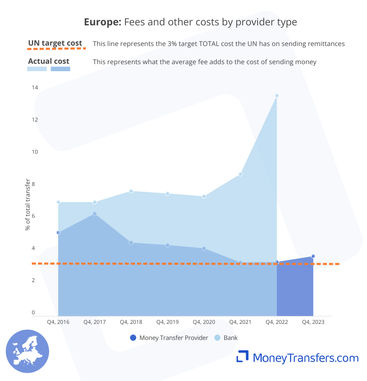
This graph shows all data for the same 2016 to-date period.
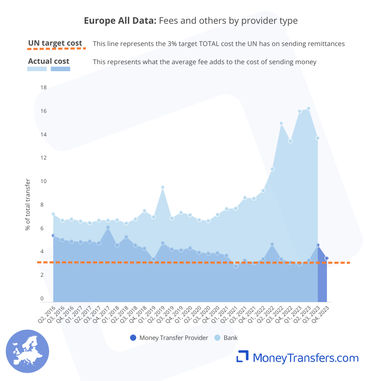
The following data show the actual numbers behind the graphs. This is again presented as the average percentage of the total transfer.
Date: Quarter, Year | Money transfer provider | Bank |
|---|---|---|
Q2, 2016 | 5.66% | 7.50% |
Q3, 2016 | 5.30% | 6.97% |
Q4, 2016 | 5.18% | 7.09% |
Q1, 2017 | 5.15% | 6.92% |
Q2, 2017 | 5.16% | 6.75% |
Q3, 2017 | 5.04% | 6.97% |
Q4, 2017 | 6.37% | No data |
Q1, 2018 | 4.88% | 7.00% |
Q2, 2018 | 5.57% | 6.73% |
Q3, 2018 | 4.85% | 7.08% |
Q4, 2018 | 4.56% | 7.79% |
Q1, 2019 | 3.68% | 7.26% |
Q2, 2019 | 5.02% | 9.80% |
Q3, 2019 | 4.50% | 7.16% |
Q4, 2019 | 4.42% | 7.64% |
Q1, 2020 | 4.63% | 7.44% |
Q2, 2020 | 4.23% | 7.03% |
Q3, 2020 | 4.17% | 6.95% |
Q4, 2020 | 4.21% | 7.45% |
Q1, 2021 | 3.99% | 7.94% |
Q2, 2021 | 3.07% | 7.99% |
Q3, 2021 | 3.56% | 8.91% |
Q4, 2021 | 3.34% | 8.85% |
Q1, 2022 | 3.67% | 9.50% |
Q2, 2022 | 4.95% | 11.34% |
Q3, 2022 | 3.66% | 15.25% |
Q4, 2022 | 3.37% | 13.73% |
Q1, 2023 | 3.24% | 16.28% |
Q2, 2023 | 3.56% | 16.51% |
Q3, 2023 | 4.85% | 13.99% |
Q4, 2023 | 3.72% | No data |
How exchange rate markup and fees make up the total cost
The below graph shows the split between the exchange rate and other costs that make up the average cost of a transfer.
Generally, a money transfer operator is the cheapest option for sending money to Europe. This is because the combination of lower fees and a slightly higher exchange rate outweighs the lower exchange rate and high fees charged by a bank.
On average, the exchange rate markup makes up about 60% of the total cost of sending money to Europe. Compared to South America, where the amount is around 50%.
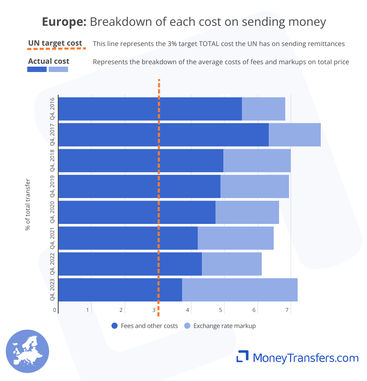
Exchange rate and fees by type of company
Exchange rate and fees by type of companyIn this section, we have covered various types of companies, including hybrid companies, post offices, and mobile operators. The figures provided for these companies are accurate, although the testing was conducted with a smaller number of transfers.
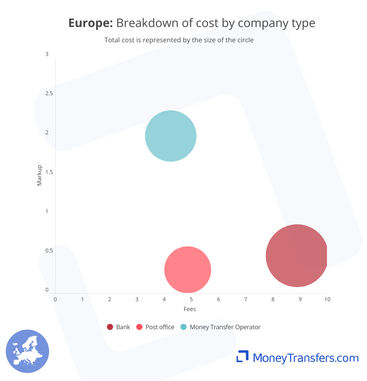
Data for the type of company
Our data
This data has been compiled from the following sources:
WorldBank and UN data on access to remittance and the cost of remittances through different provider types.
Live data from our own comparison engine.
All data has been edited and fact checked by our team.
Explore remittance statistics
Our remittance data center is always growing.
We often cover new topics and will regularly update reports as new data emerges.

.svg)
Contributors


